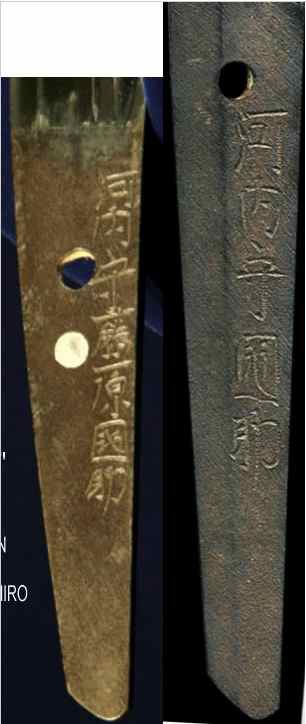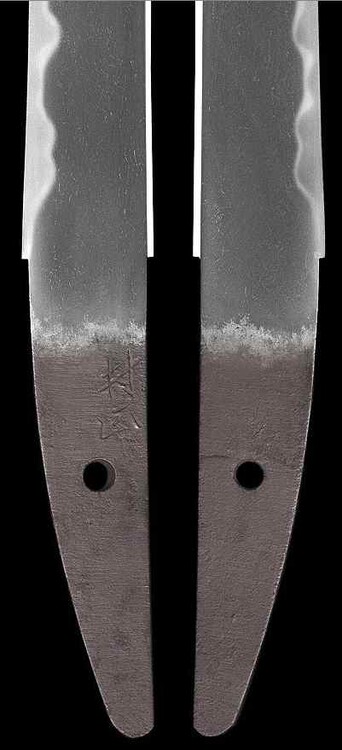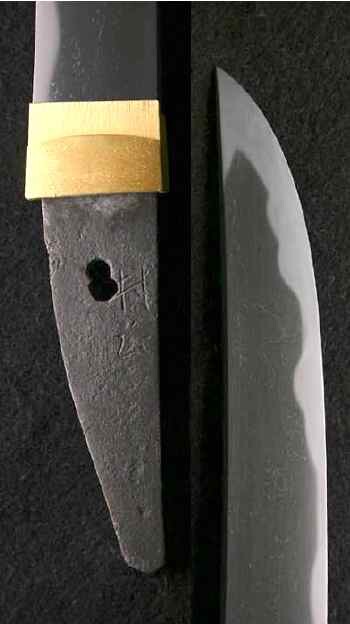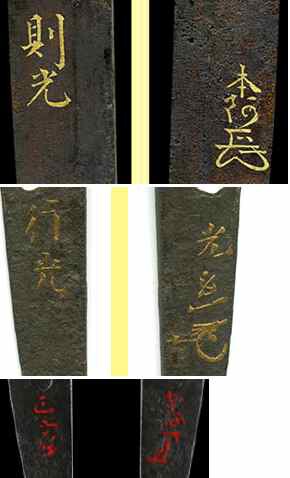-
Posts
1,029 -
Joined
-
Last visited
Content Type
Profiles
Forums
Events
Store
Downloads
Gallery
Everything posted by Eric H
-
MFA Boston - Goto Ichijo - and a very similar Tsuba by Goto Ichijo for sale http://www.aoi-art.com/fittings/tsuba/F10396.html Eric
-
-
-
Well, I prefer to refer to authentic sources namely Fujishiro Koto-Hen Pics from left to right - Muramasa shodai - Muramasa nidai - Muramasa sandai Eric Page 255 Plate I: EISHÔ JÛNEN MIZUNOTO-TORI JÛGATSU JÛSANNICHI Plate II: MURAMASA, MYÔHÔRENGEKYO (The Lotus Sutra) The "Jûgatsu Jûsannichi" inscription to the right is the death anniversary of Nichiren Shônin Page 257 Plate I: MURAMASA Plate II: HAKO MIDARE This is called a hako midare which has collections of nioi appearing, a narrow ha and gonome choji. This is a blade which resembles Sengo Masashige, Mino Kanesada and Kanefusa, Shimada Yoshisuke and Sukemune, and Heianjô Nagayoshi nado. Most of the works of Nagayoshi and Nosada have a gentle ha, and Muramasa and Nosada also have works with severe togari in the ha. Plate III: SEISHÛ KUWANA GUN MORITA SHÔ FUJIWARA ASON MURAMASA SAKU Plate IV: TENMON JÛNINEN MIZUNOTO-U GOGATSU HI Page 258 Plate I: SEISHÛ KUWANA FUJIWARA ASON MURAMASA SAKU Plate II: TENMON NIJÛNINEN KUGATSU KICHIJITSU Irregularities can be seen in the mei kanji, but this is probably one done in his old age. MURAMASA SANDAI [TENSHÔ 1573 ISE] SUEKOTÔ CHÛJÔSAKU He is probably the son of Muramasa of the Daiei era. His works seem to be extremely few. Signature: MURAMASA Plate III: MURAMASA
-
Japan is generally a rainy country with high humidity...the best environment for lacquer. Outside of Japan a relative humidity of ca. 55% and a temperature of ca. 18 C would be ideal for Japanese lacquer. Light irradiation, the less the better. Eric
-
I think an important aspect when talking about sword lengths is the relationship to its wearer, the Samurai... his body height and arm‘s length. I don‘t know how representative this research is, it says that the estimated human height in Edo period roughly was 155-158 cm for Men and 143-146 cm for Women. Eric 提供館 東京都江戸東京博物館 図書室 (4110007) 管理番号 edo2004-07 事例作成日 2004年07月01日 登録日時 2005年01月26日 15時08分 最終更新日時 2010年10月05日 13時07分 質 問 江戸時代の男女の平均身長はどれくらいか。 回 答 江戸時代の人の身長は、墓地などから発掘された人骨(おもに大腿骨)の長さから推定されています。推定身長を出すための計算式や、サンプルの採り方などで若干の差はありますが、おおむね“男性155~158cm”“女性143~146cm”の範囲内におさまるようです。 (1)『骨は語る 将軍・大名家の人々(*)』(鈴木尚著 東京大学出版会 1985年 4694/1/89)には、江戸時代庶民の平均は“男性157.11cm”“女性145.62cm”とあります。 (*)徳川将軍とその正室・側室や、江戸時代の大名の推定身長なども載っています。 (2)『日本人のからだ』(鈴木隆雄著 朝倉書店 1996年 4911/3/96)では“男性155.09~156.49cm,女性143.03~144.77cm(江戸時代前期~後期)”。 (3)「江戸時代人の身長と棺の大きさ(**)」平本嘉助(『江戸時代の墓と葬制 江戸遺跡研究会第9回大会発表要旨』江戸遺跡研究会 1996年 2102/115/9)では江戸庶民の平均が“男性155~156cm,女性143~145cm(江戸時代前期~後期)”。“将軍・大名(男性)の平均が157cm”“正室・側室(女性)が145cm”で階級による大きな身長差はなかった、と推察しています。 (**)同発表要旨を元に改稿された論文が『墓と埋葬と江戸時代』(江戸遺跡研究会編 吉川弘文館 2004年 3856/26/004)に掲載されいてます。 現在の日本人の体型と比べるとだいぶ小柄だったといえますが、すべての人が小柄だったわけではなく、身長2mを越す大男もいました。文政期の看板力士“大空武左衛門”や天保期の看板力士“生月鯨太左衛門”は身の丈7尺5寸(約227cm)もあったと言われています。(『古今大相撲力士事典』(景山忠弘 小池謙一著 国書刊行会 1989年 7881/10/89)参考)
-
Some confusing comments in this thread. Let‘s go to the facts, as they are unmistakably established and used in current origamis. Tanto - under 1 shaku (30.3 cm) Wakizashi - between 1 and 2 shaku Katana - over 2 shaku There are blades, „sunnobi“ Tantos, which are slightly over 1 shaku. However a blade 60.5 cm is classified as Wakizashi when using the above standard. Therefore your Daisho is by defintion composed by 2 Wakizashi. Eric
-
an interesting read http://home.earthlink.net/~jggilbert/NTHK.htm Eric
-
-
I‘m referring to the statement of Keith G „Ubu Mumei!" ...but even he will submit a freshly polished sword to Shinsa. Owners of a mumei sword "normally" would like to know by whom it was made or at least to which school it belongs. Others with signed but not papered swords want affirmation by Shinsa, also those with swords bearing big names. There is only one way, submit to Shinsa. Eric
-
-
All generations Muramasa’s features are same. It’s that Hamon of both sides are same shape. No rule without exception Eric
-
The Mishina school in Kyoto was divided in 4 schools: Kyo Tamba no Kami - Fushimi Tamba no Kami - Osaka Tamba no Kami - Yamato no Kami. This illustrates the difficulty for Westerners, lacking the background in language, material on hand, and knowledge compared to the Japanese experts, the very need of Shinsa. Regarding mumei swords, whether suriage or ubu, I state that even those who stick up for mumei...finally tend to submit their swords to Shinsa... Eric
-
Well, I don‘t believe to see mizukage in your explanation...mizukage runs diagonally into the ji...example Tanto by Horikawa Kunihiro who is known for mizukage sometimes seen in his swords...but do not misunderstand, in his case it‘s not a side effect of retempering. Eric
-
This Tanto is saiha. One of the signs of a saiha blade is the appearance of the nakago...in this case it is clearly pockmarked. Eric
-
1 - HONAMI KOKAN - Kinzogan mei 2 - HONAMI KOSON - Kinpun-mei 3 - HONAMI KOYU - Shu-mei All have been affirmed by NBTHK and given Juyo Token. Eric
-
Kumihimo - Sageo making... http://www.15-1a.com/sageo/ Eric
-
Comparison with a shoshin mei Izumi no Kami Fujiwara Kunisada (Oya Kunisada)...in all my examples the mei is without "saku". Eric
-
-
-
Indeed... I wonder what other members are able to see anything of interest in this item. It‘s a gimei specimen not worth to be treated, i.e repaired furthermore. Eric
-
-
Gentlemen, No reply on the last contribution has been made, I allow myself to upload a Hazama Tsuba 8 x 7.9 x 0.4 cm, red copper with sahari and gold hon zogan...only to study purposes...not to hijack the topic. Eric
-
with pleasure Eric 1 - Tanto 32.1 cm 2 - Katana 67.6 cm 3 - Katana 71.3 cm 4 - Katana 69 cm 5 - Sayagaki Tanzan Katana 4 is Tokubetsu Hozon






























